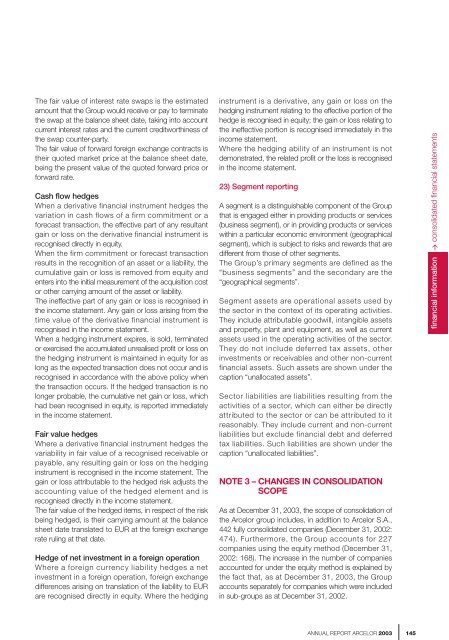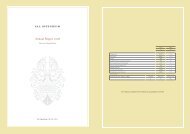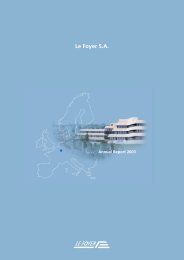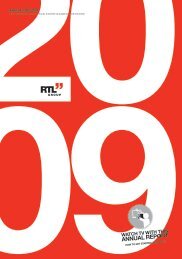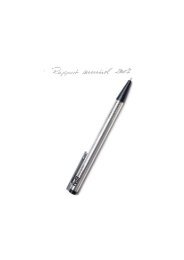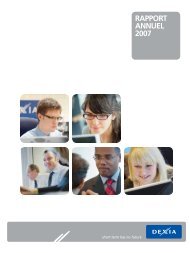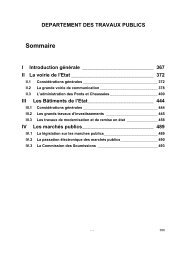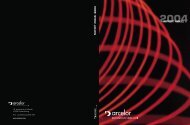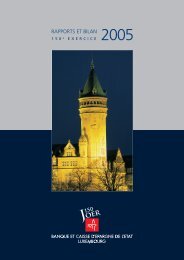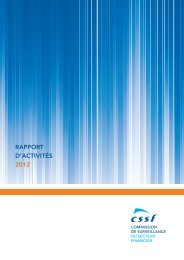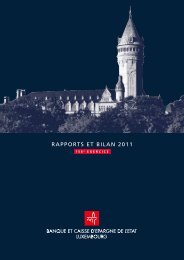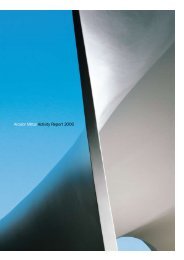ANNUAL REPORT ARCELOR 2003 - paperJam
ANNUAL REPORT ARCELOR 2003 - paperJam
ANNUAL REPORT ARCELOR 2003 - paperJam
You also want an ePaper? Increase the reach of your titles
YUMPU automatically turns print PDFs into web optimized ePapers that Google loves.
The fair value of interest rate swaps is the estimatedamount that the Group would receive or pay to terminatethe swap at the balance sheet date, taking into accountcurrent interest rates and the current creditworthiness ofthe swap counter-party.The fair value of forward foreign exchange contracts istheir quoted market price at the balance sheet date,being the present value of the quoted forward price orforward rate.Cash flow hedgesWhen a derivative financial instrument hedges thevariation in cash flows of a firm commitment or aforecast transaction, the effective part of any resultantgain or loss on the derivative financial instrument isrecognised directly in equity.When the firm commitment or forecast transactionresults in the recognition of an asset or a liability, thecumulative gain or loss is removed from equity andenters into the initial measurement of the acquisition costor other carrying amount of the asset or liability.The ineffective part of any gain or loss is recognised inthe income statement. Any gain or loss arising from thetime value of the derivative financial instrument isrecognised in the income statement.When a hedging instrument expires, is sold, terminatedor exercised the accumulated unrealised profit or loss onthe hedging instrument is maintained in equity for aslong as the expected transaction does not occur and isrecognised in accordance with the above policy whenthe transaction occurs. If the hedged transaction is nolonger probable, the cumulative net gain or loss, whichhad been recognised in equity, is reported immediatelyin the income statement.Fair value hedgesWhere a derivative financial instrument hedges thevariability in fair value of a recognised receivable orpayable, any resulting gain or loss on the hedginginstrument is recognised in the income statement. Thegain or loss attributable to the hedged risk adjusts theaccounting value of the hedged element and isrecognised directly in the income statement.The fair value of the hedged items, in respect of the riskbeing hedged, is their carrying amount at the balancesheet date translated to EUR at the foreign exchangerate ruling at that date.Hedge of net investment in a foreign operationWhere a foreign currency liability hedges a netinvestment in a foreign operation, foreign exchangedifferences arising on translation of the liability to EURare recognised directly in equity. Where the hedginginstrument is a derivative, any gain or loss on thehedging instrument relating to the effective portion of thehedge is recognised in equity; the gain or loss relating tothe ineffective portion is recognised immediately in theincome statement.Where the hedging ability of an instrument is notdemonstrated, the related profit or the loss is recognisedin the income statement.23) Segment reportingA segment is a distinguishable component of the Groupthat is engaged either in providing products or services(business segment), or in providing products or serviceswithin a particular economic environment (geographicalsegment), which is subject to risks and rewards that aredifferent from those of other segments.The Group’s primary segments are defined as the“business segments” and the secondary are the“geographical segments”.Segment assets are operational assets used bythe sector in the context of its operating activities.They include attributable goodwill, intangible assetsand property, plant and equipment, as well as currentassets used in the operating activities of the sector.They do not include deferred tax assets, otherinvestments or receivables and other non-currentfinancial assets. Such assets are shown under thecaption “unallocated assets”.Sector liabilities are liabilities resulting from theactivities of a sector, which can either be directlyattributed to the sector or can be attributed to itreasonably. They include current and non-currentliabilities but exclude financial debt and deferredtax liabilities. Such liabilities are shown under thecaption “unallocated liabilities”.NOTE 3 – CHANGES IN CONSOLIDATIONSCOPEAs at December 31, <strong>2003</strong>, the scope of consolidation ofthe Arcelor group includes, in addition to Arcelor S.A.,442 fully consolidated companies (December 31, 2002:474). Furthermore, the Group accounts for 227companies using the equity method (December 31,2002: 168). The increase in the number of companiesaccounted for under the equity method is explained bythe fact that, as at December 31, <strong>2003</strong>, the Groupaccounts separately for companies which were includedin sub-groups as at December 31, 2002.financial information > consolidated financial statements<strong>ANNUAL</strong> <strong>REPORT</strong> <strong>ARCELOR</strong> <strong>2003</strong> 145


